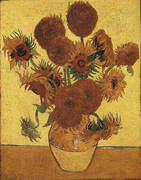Vase with Fifteen Sunflowers 1888 By Vincent van Gogh
Vincent van Gogh's Sunflowers paintings need no introduction. They are some of the most iconic and loved art reproductions ever. Vincent van Gogh's paintings embody platonic non-sexual love, with sunflowers always following the sun. Sunflower paintings represent the beauty and energy of the natural world and appear in many of Vincent Van Gogh's famous paintings. In contrast with Impressionist paintings of short brushstrokes, Van Gogh's Sunflowers use elongated brushstrokes. Indeed, the curved lines almost veer towards an Art Nouveau style. Van Gogh created painted sunflowers throughout his life.
Where is Van Gogh's Original Sunflowers Painting?
Van Gogh's Sunflowers 1889 is one of seven versions in a series of Vincent van Gogh paintings. Five examples remain on display in museums around the world. One resides in a private collection, while another, purchased by a Japanese collector, was sadly destroyed during World War II. The best-known Sunflower painting hangs in the National Gallery, London. Other Vincent van Gogh sunflower paintings are in the Van Gogh Museum in Amsterdam, the Philadelphia Museum of Art, the Sompo Museum in Tokyo, and the Neue Pinakothek in Munich, Germany.
What do Sunflowers Paintings represent?
Sunflowers represent Dutch art's “vanitas” tradition of the certainty of death and the transience of life. Van Gogh’s Vase with Fifteen Sunflowers painting relates to different life cycles. Some Sunflowers are unopened buds, some are blooming, and others are heading toward eventual decay. In Dutch culture, sunflowers reference a Christian belief of trusting and following Christ. For Van Gogh, this devotion represents his dedication to art and beauty. The association with art, faith, and love makes sunflowers an appropriate subject for welcoming Paul Gauguin to Arles.
Why did Van Gogh Create Yellow Sunflower paintings?
Van Gogh saw yellow as the color of happiness. He wrote to his brother, saying, 'The Sunflower is mine.' No other artist is as closely related to specific flowers as Vincent Van Gogh, and we know little of his reasons for choosing them. However, in the most direct explanation, he wrote to the art critic Albert Aurier, describing how sunflowers personally symbolized 'gratitude.' Van Gogh’s 1889 Sunflowers painting appears during a rare moment of intense optimism and personal excitement. He was awaiting the arrival of Paul Gauguin at his home in Arles. He hoped the two men would pioneer an artists' colony and foster a long-term creative partnership. Despite this, Van Gogh's Sunflowers also represent the tragic cycles of life and death. Paintings of Sunflowers may have been chosen for their transient beauty, as the petals rapidly fade after a short period of bright, beautiful blooms.
Did Van Gogh create paintings for Paul Gauguin?
Aside from their symbolic importance, Van Gogh also knew Gauguin liked his sunflower paintings. So, while he didn’t paint them directly for Gauguin, he was eager to hear his friend’s esteemed artistic opinion. Sadly, Gauguin frequently criticized Van Gogh’s paintings. The emotional anguish from frequent arguments was too much for him to bear. This period of Van Gogh’s life is well-documented, culminating in Van Gogh severing his ear. Two van Gogh self portrait paintings ensued; Self Portrait with Bandaged Ear and Pipe and Self Portrait with Bandaged Ear Arles, both painted in 1889.
When did Van Gogh start his Sunflowers paintings?
On his arrival in Paris in 1886, Van Gogh adored the bright, colorful paintings of Pierre Auguste Renoir. The impressionist artists' use of contrasting colors and expressive techniques transformed Van Gogh’s paintings, leading to experimentation with unmixed, vivid colors. Sunflowers appear in many of Van Gogh's still life, drawings, and sketches. However, Van Gogh’s “Sunflower series” refers to oil paintings created in 1888 and 1889. While some paintings of sunflowers may have been lost or destroyed, we know of seven artworks forming the series.
These seven paintings form two main phases. The first phase commenced in August 1888. Van Gogh painted all four artworks in just one week, writing to his brother Theo that he worked “with the gusto of a Marseillaise eating bouillabaisse.” The artist further commented that if he continued at a similar rate, he’d soon have “twelve or more paintings,” transforming his room into a “symphony in blue and yellow.” Van Gogh painted three other replica paintings of Sunflowers in January 1889. He described them as “absolutely equal” and identical to the previous works. Van Gogh created art reproductions to display as side panels for his portrait painting of Madame Roulin in 1888.
Why is van Gogh's Sunflower Painting Special?
Van Gogh’s Sunflowers are unique for many reasons. First, they represent a stunning presentation of painterly skill and vibrant beauty. The flowers themselves mirror the sun and heat of Provence, with each floral orb referencing the fiery sun itself. In addition, they are some of the first paintings produced by Van Gogh after moving to Arles. They reflect his growing artistic and personal self-confidence. Indeed, Sunflowers paintings demonstrate the artist’s new expressive and post-impressionist style.
Van Gogh described his famous Sunflower art as simply ‘a picture all in yellow’. Yet the yellows astound in their variety. From greenish yellows in the background, they range to vivid orange ochres. Today, Vincent van Gogh's Sunflowers are some of art history's most famous oil paintings.
High quality art reproductions of Vincent van Gogh's paintings of Sunflowers are for sale in our Impressionist paintings art collection.
We offer a 100% money back guarantee or replacement service. If for any reason you are dissatisfied with your painting please contact us within 7 days of receipt, advising the reason you are unhappy and we will provide you with all the information you need for its return or replacement.
We ship free to anywhere in the world via FedEx or DHL expedited service with online tracking.
Your painting will be shipped rolled in strong plastic tubing, ready for stretching and/or framing locally. This is the conventional method of transporting hand-painted oil on canvas. Learn more about how your painting is shipped.
We are able to offer a framing service intercontinental U.S. Please contact us if you would like a quotation. Alternatively, should you prefer, we can recommend a framer in your area.
Notes About Your Painting
Please note that replica oil paintings are finished with an additional 10cm (4") of extra canvas on all sides, allowing ample surplus canvas for stretching and framing.
Recently Viewed:
Cannot Find What You Are Looking For?
Reproduction Gallery Information
Customer Service
(Send Us A Message)
Tel: (503) 937 2010
Fax: (503) 937 2011







